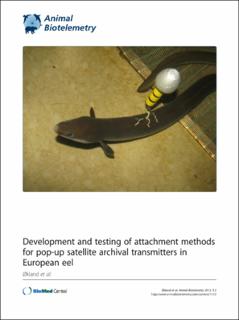| dc.contributor.author | Økland, Finn | |
| dc.contributor.author | Thorstad, Eva Bonsak | |
| dc.contributor.author | Westerberg, Håkan | |
| dc.contributor.author | Aarestrup, Kim | |
| dc.contributor.author | Metcalfe, Julian D. | |
| dc.date.accessioned | 2023-07-10T07:54:27Z | |
| dc.date.available | 2023-07-10T07:54:27Z | |
| dc.date.created | 2013-04-19T15:13:23Z | |
| dc.date.issued | 2013 | |
| dc.identifier.citation | Animal Biotelemetry. 2013, 1 . | en_US |
| dc.identifier.issn | 2050-3385 | |
| dc.identifier.uri | https://hdl.handle.net/11250/3077431 | |
| dc.description.abstract | Background: Four methods for attaching pop-up satellite transmitters to European eel were tested in the laboratory by recording long-term tag retention, growth and survival; short-term behavioral responses; and physical damage from attachments. Results: All eels survived until they lost their tag, or until end of the six-month study. Specific growth rate did not differ between tagged fish and controls. Tag retention varied from 0% to 100% among attachment methods. A tagging method that uses the strength of the eel skin by attaching the tag to the skin at three points is recommended for ocean migration studies based on a long tag retention time, minimal behavioral reactions, negligible damage to the swimming muscle, and minimal physical damage both for fish retaining and losing the tag. Although tag retention was 50% over six months, those losing their tags still retained them for 114 to 134 days. Another method had higher tag retention (100%), but required the use of steel wires that moved upwards through the muscle over time. This method was regarded as less suitable because of a strong behavioral reaction in the first two days after tagging and damage to the swimming muscle. Results from 275 silver eels released on European coasts equipped with pop-up satellite transmitters or similarly sized pop-up data storage tags to study the ocean spawning migration indicated a large premature tag release. This was partly related to mechanical tag loss, but probably mainly to a high predation rate (>20% confirmed predations of eels with pop-up satellite transmitters). Mean time to premature tag release was 14 to 21 days (maximum nine months). Conclusions: Laboratory and field data showed that pop-up satellite transmitters attached to eels can remain attached for six to nine months, but that tag retention is a challenge. Hiding behavior in a structured habitat increased the risk of entanglement and tag loss. In ocean migration studies, consideration should be given to transportation and release off shore instead of in shallower areas where they are more likely to seek the seabed and hide in structured habitats. Behavioral reactions indicate that data recorded during the first two to three days after tagging may not reflect natural behavior. | en_US |
| dc.description.abstract | Development and testing of attachment methods for pop-up satellite archival transmitters in European eel | en_US |
| dc.language.iso | eng | en_US |
| dc.relation.uri | http://www.animalbiotelemetry.com/content/1/1/3 | |
| dc.rights | Navngivelse 4.0 Internasjonal | * |
| dc.rights.uri | http://creativecommons.org/licenses/by/4.0/deed.no | * |
| dc.subject | Data storage tag | en_US |
| dc.subject | Satellite tag | en_US |
| dc.subject | External tagging | en_US |
| dc.subject | Tagging effect | en_US |
| dc.subject | Telemetry | en_US |
| dc.title | Development and testing of attachment methods for pop-up satellite archival transmitters in European eel | en_US |
| dc.title.alternative | Development and testing of attachment methods for pop-up satellite archival transmitters in European eel | en_US |
| dc.type | Peer reviewed | en_US |
| dc.description.version | publishedVersion | en_US |
| dc.source.pagenumber | 13 | en_US |
| dc.source.volume | 1 | en_US |
| dc.source.journal | Animal Biotelemetry | en_US |
| dc.identifier.doi | 10.1186/2050-3385-1-3 | |
| dc.identifier.cristin | 1024720 | |
| dc.source.articlenumber | 3 | en_US |
| cristin.unitcode | 7511,3,0,0 | |
| cristin.unitname | Avdeling for akvatisk økologi | |
| cristin.ispublished | true | |
| cristin.fulltext | original | |
| cristin.qualitycode | 1 | |

